Sample Employee Verification Letters
-
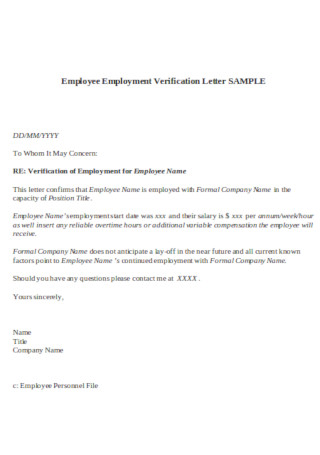
Employee Employment Verification Letter
download now -
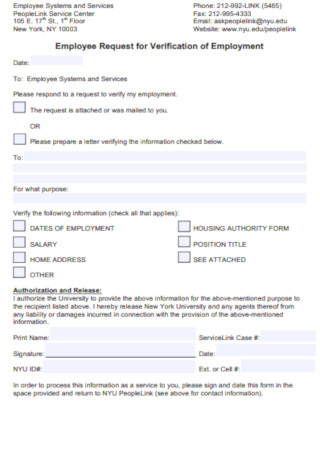
Employee Request for Verification of Employment Letter
download now -
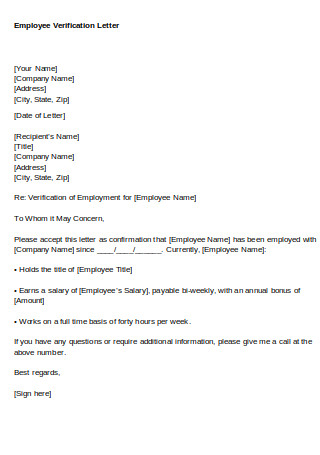
Sample Employee Verification Letter
download now -
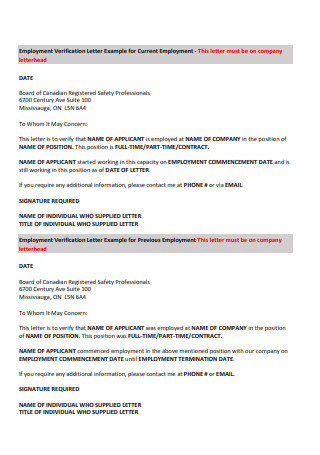
Employment Verification Letter Example for Current Template
download now -

Sample Employment Verification Letter Example
download now -

Sample Employee Verification Letter for Perm Template
download now -
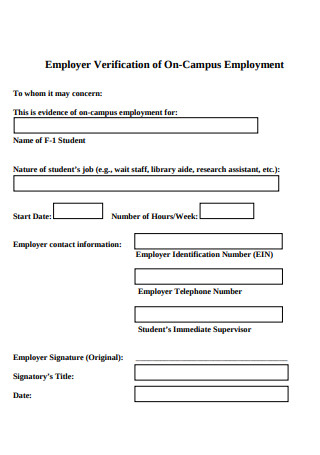
Employer Verification of On-Campus Employment Letter
download now -

Employee Request for Verification of Employment Letter
download now -
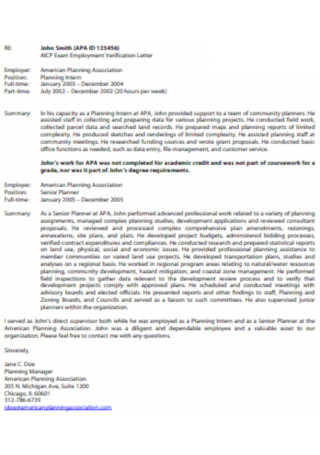
Basic Employee Employee Verification Letter
download now -
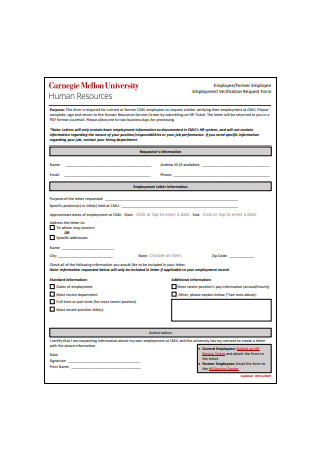
Former Employee Employment Verification Request Form
download now -
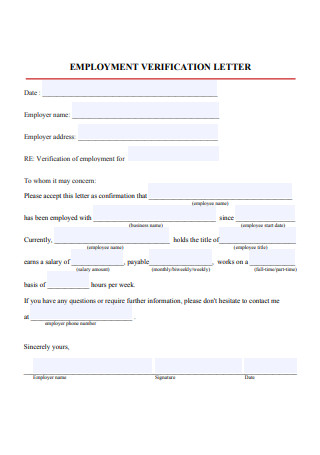
Basic Employement Verification Letter Template
download now -
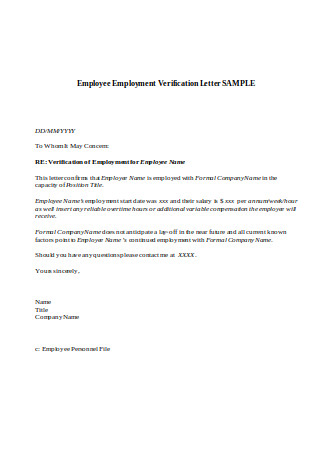
Sample Employee Employment Verification Letter
download now
FREE Employee Verification Letter s to Download
Sample Employee Verification Letters
What Is an Employee Verification Letter?
Benefits of Employee Performance Appraisals
How to Improve Employee Performance
FAQs
Is an employment verification letter necessary?
Who can write an employment verification letter?
How does HR verify past employment?
What Is an Employee Verification Letter?
A current or former employer writes a letter of employment verification to confirm that an employee or former employee worked for the organization. The request could originate from the employee, government agencies, prospective landlords, mortgage lenders, potential employers, or collection agencies. The request may involve verification of the employee’s employment dates, remuneration, and eligibility for rehiring or continuation of employment. The requestor may inquire about the reason for the employee’s termination if the employee has been terminated.
Benefits of Employee Performance Appraisals
Many organizations will soon conduct employee performance reviews at this time of year. Whether your performance report cycle is monthly, quarterly, or biannual, it’s almost time to check in with your staff. Yet, performance reviews can be unpleasant for all parties involved and only sometimes provide the desired result. Only 14% of employees believe that performance evaluation sample drive them to develop. 95% of managers are dissatisfied with their company’s review procedures. Before the next review cycle, you should analyze the top advantages of the employee performance evaluation. Therefore you may approach this review period positively, prepared to give your employees more autonomy.
How to Improve Employee Performance
Performance evaluations can intimidate employees and supervisors but are an essential beginning point. Properly reviewing an employee’s performance may save valuable time and resources on improvement strategies that address the issue’s root. During this phase, thoroughly evaluate the individual’s performance to give a firm foundation for improvement initiatives. Secondly, you must use the evaluation’s findings to construct an improvement plan that addresses any opportunities or development areas that have been identified.
1. Determine Why the Worker Is Not Reaching Expectations
The list of reasons why an employee is underperforming can be exhaustive. It’s nearly impossible to take the appropriate actions to enhance it if you don’t resolve issues. Have an open and honest conversation with the employee to determine whether anything impedes their performance. It could be that they believe the firm is preventing them from fulfilling their full potential, that they lack the necessary resources, that they do not feel aligned with company goals, or that they need to receive adequate supervision or training. Factors affecting employment may have nothing to do with work. Personal factors, such as poor mental health or emotional problems, can negatively impact an employee’s performance. This chat will allow you to deliver more effective support.
2. Discuss Both the Highs and Lows
Although improvement is the ultimate objective, performance appraisals should focus on more than what’s not working. Concentrating solely on areas for development could erode the trust of your staff and lead to resentment if they believe their efforts in other areas need to be recognized. Be sure to let your team know what they’re doing well and highlight any performance highlights since their last evaluation and opportunities for improvement. When you acknowledge an employee’s efforts, they will realize they are a valued team member and continue to work diligently. Yet, when discussing obstacles and development opportunities, you must be transparent about any issues. The path of slightest opposition would be to “soften the blow.” Still, by failing to identify the precise nature of the problem, you will exacerbate it over time, and the relationship may grow more antagonistic. Ensure that the employee leaves the session with a clear awareness of their strengths, areas for improvement, and the necessary steps to achieve their goals since this will reduce stress. While providing feedback evaluation, you must constantly consider the well-being of your employees. Ensuring you are providing them with only a little work is prudent. Alternatively, they feel out of their depth.
3. Provide Continuous Feedback as They Advance
The most effective method for enhancing employee performance is to provide consistent feedback. By providing frequent feedback, you may assist employees in staying on track while they seek to improve rather than waiting for a formal review to address any difficulties. The ramifications of lousy performance may have devastated the team or business by that point. Frequent feedback makes employees more accustomed to getting feedback in general. It can also eliminate any negative associations people have with receiving comments. Regular feedback will likely include positive and constructive comments, keeping employees engaged and upbeat instead of demoralized. For performance enhancement, employees must understand where they stand and their progress. They will therefore be more aware of how they are performing and what steps are necessary for continued improvement. Using this knowledge in a strategy for performance enhancement will benefit both of you.
4. Develop a Positive Work Environment
A positive workplace culture paves the path for improved engagement, motivation, and performance. Examine factors such as the degree to which employees are aligned with the company’s vision and mission, the employee perks provided, and the business’s operations – for instance, the work environment and factors such as flexibility or holiday rules. The workplace culture should enable employees to perform to their fullest potential. A robust, high-performance workplace culture allows individuals to be focused and engaged without any negative distractions and with the support of a positive workplace driving them ahead. The simplest way to determine whether your workplace culture suits your employees is to ask them. Use a confidential survey instrument to solicit employee feedback on business operations. While this is a private forum, your staff will feel free to provide candid feedback regarding any areas for improvement. Not only can this assist you in improving anything in the firm that may harm performance, but you can also demonstrate your appreciation for your employees by implementing their suggestions. This helps your employees feel valued and increases their engagement levels.
5. Set Measurable and Realistic Goals
An employee must understand what is being measured to aid in performance development plan. This allows them to assess their performance and try to improve it. If goals are measurable, employees can guess whether or not they are developing, and they may feel their results are subject to their manager’s judgments. Secondly, goals must be attainable. You want to set lofty goals, but anything impossible could contribute to staff fatigue. On the other side, goals that are overly simple lack motivational value. Ensure that you strike the appropriate balance. You must also clarify when you expect these goals to be accomplished. Establish two dates, one for check-in to determine the project’s progress and another for the anticipated completion date.
6. Consistently Recognize Exceptional Performance and Progress
By recognizing and rewarding good performance, you show employees that their efforts are appreciated. By developing a system that allows for regular acknowledgment, you can maintain the interest of your top achievers. Who then can demonstrate leadership and assist others? A familiar blunder leaders make is focusing excessively on underperformance rather than the daily victories their employees achieve. You must express gratitude and avoid constant criticism to keep your teams happy and productive.
FAQs
Is an employment verification letter necessary?
A letter of employment verification may be necessary when an employee applies for a position with a company, and the potential employer has to confirm that the applicant has worked for the claimed employer or in the claimed capacity.
Who can write an employment verification letter?
There are various ways to request a letter of employment verification from a current or previous employer: Ask your manager or supervisor. Typically, this is the most straightforward approach to requesting the letter. Provide complete details and context.
How does HR verify past employment?
Some hiring managers contact your present or prior employers directly to request official verification. Employers may also utilize professional background screening companies and an employment verification service.
When creating an employment verification letter for current or former employees, it is vital to follow a consistent approach, be mindful of state regulations limiting the information you share, and give accurate, formal, and brief information. Since letters of verification of work are frequently required for employees to obtain mortgage agreements, loan agreements, apartments, and new jobs, it is essential to communicate well in writing. In addition, a professional letter of recommendation can positively portray your firm as a whole.
